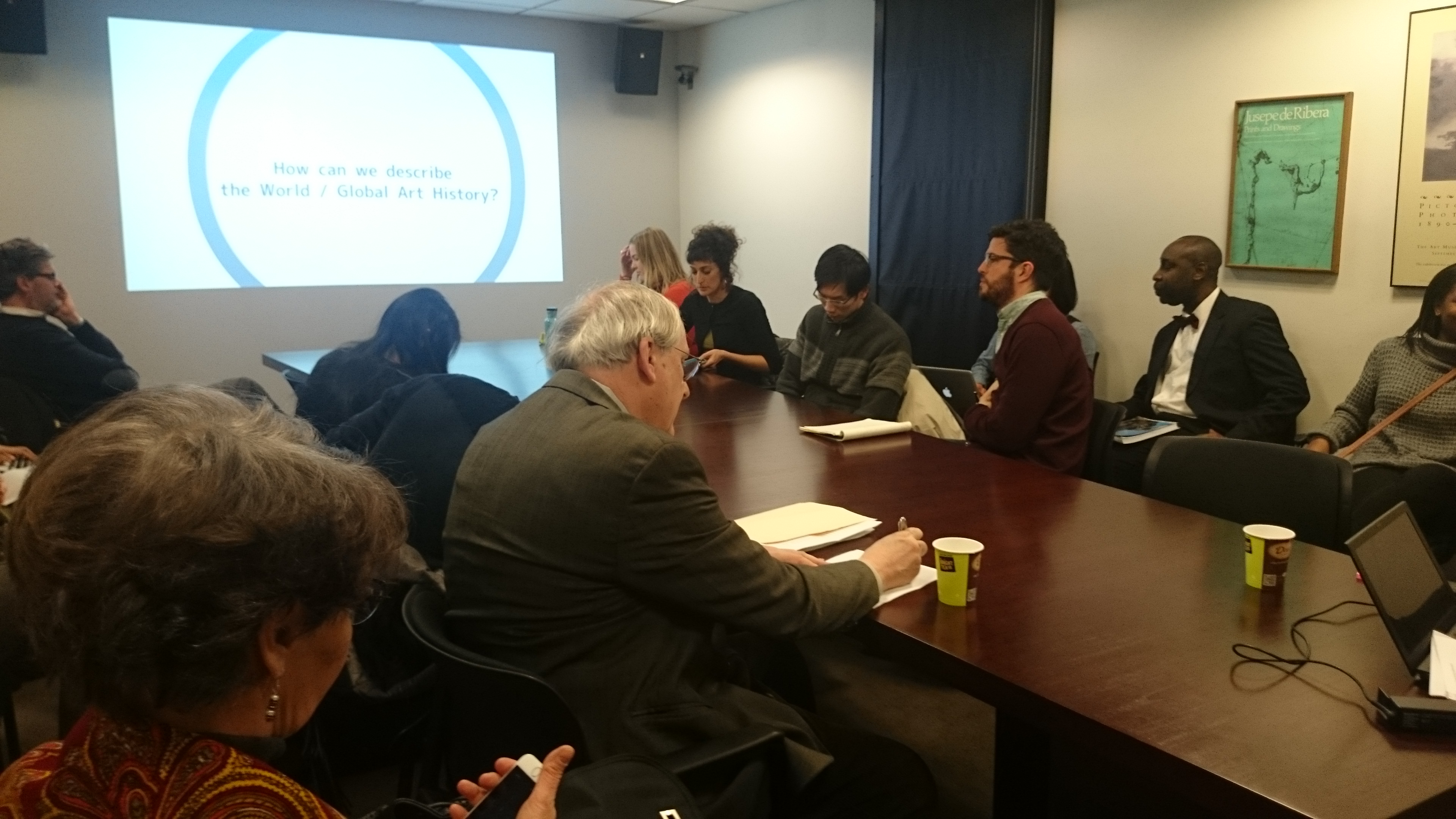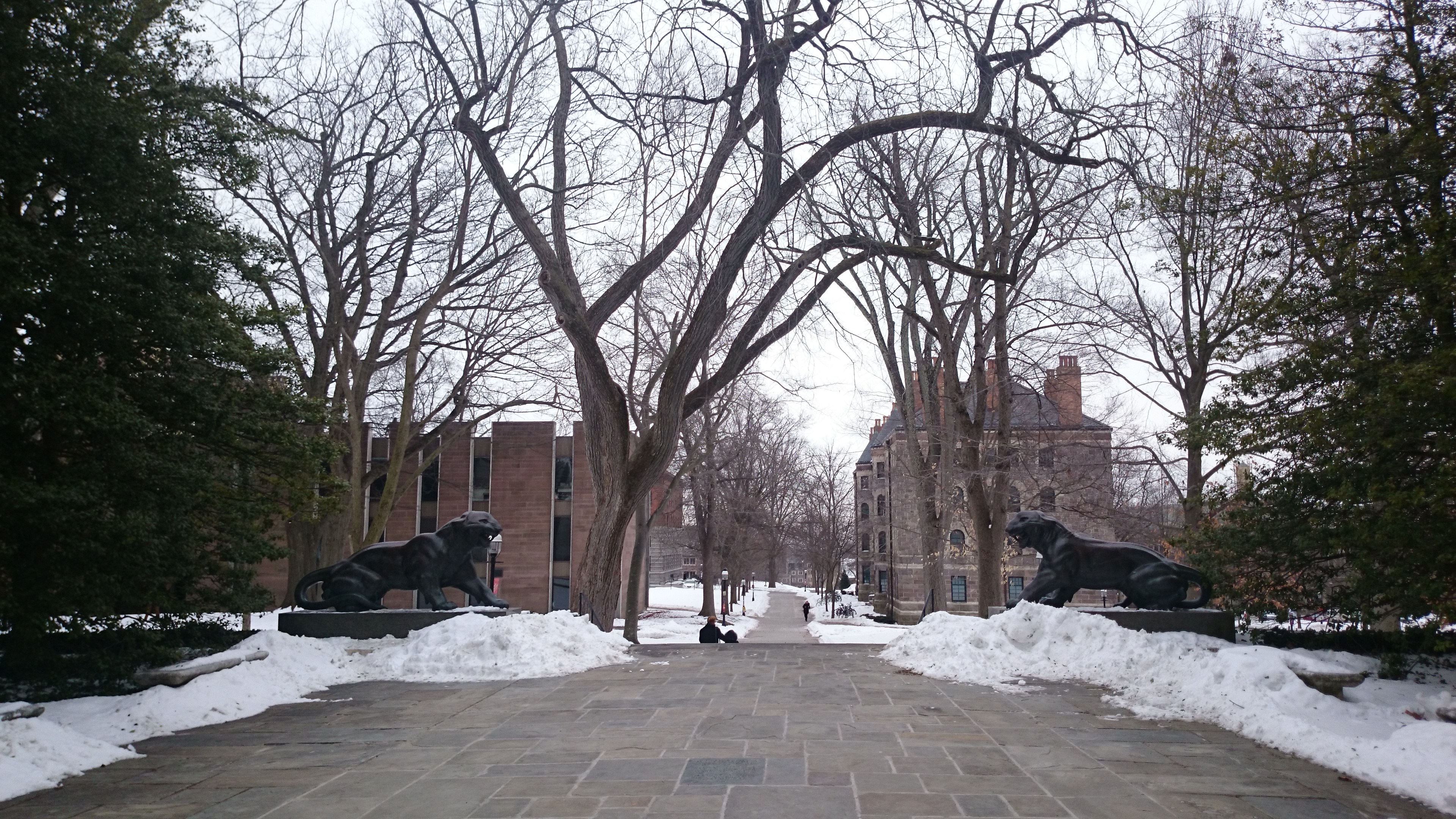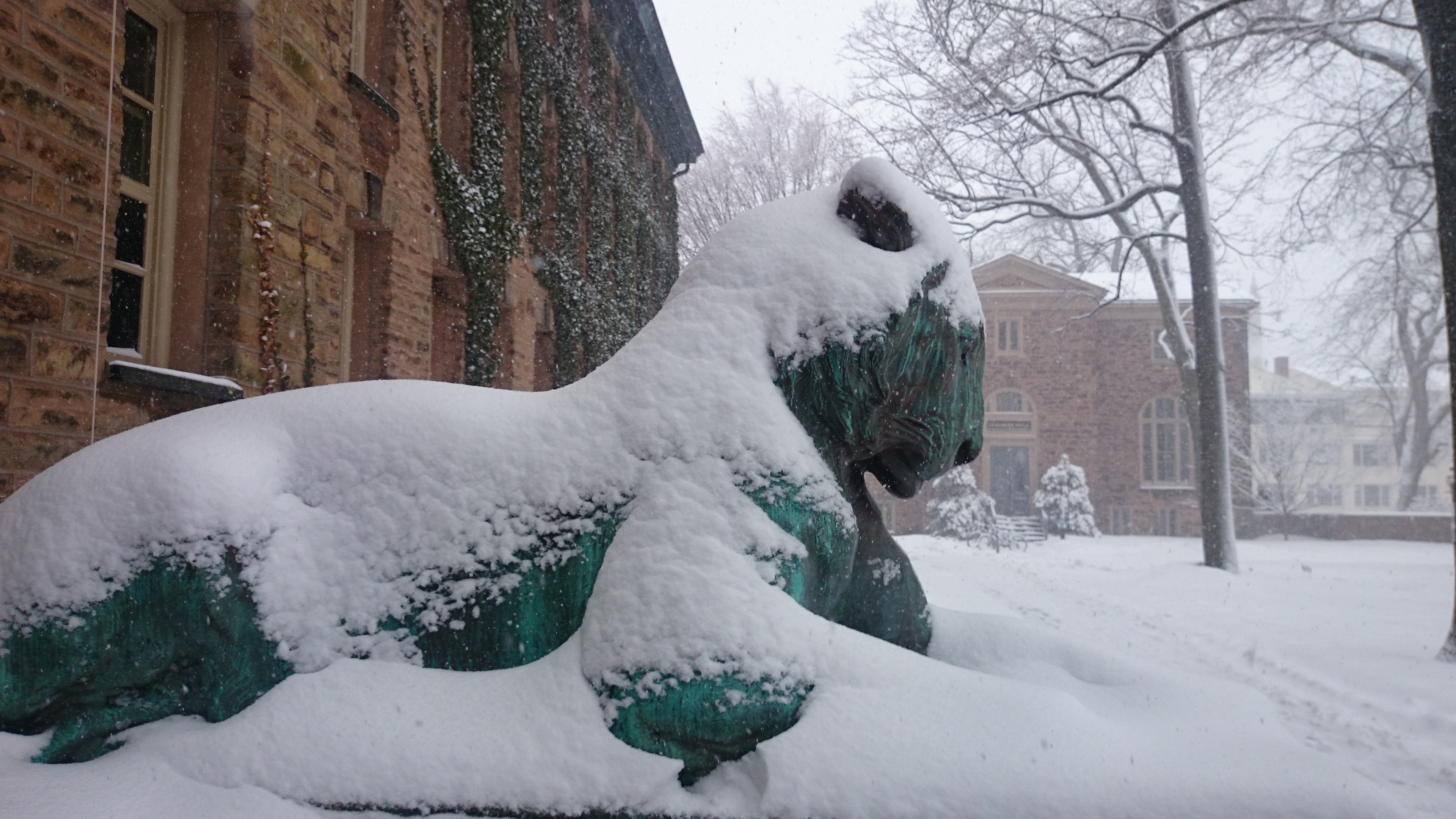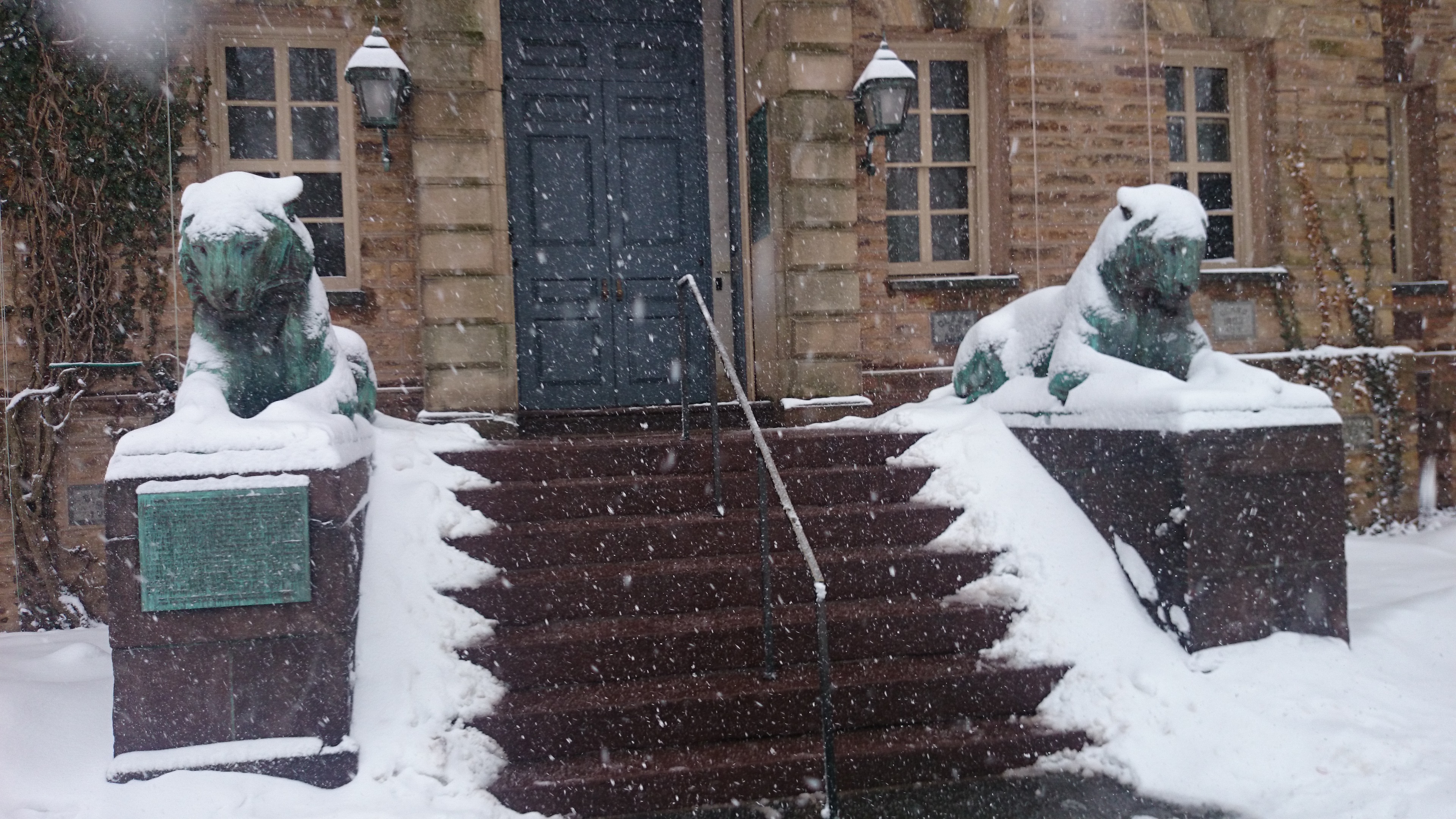2015.03.13
プリンストン大学研究者交流 1 Princeton University Researcher Exchange Program
3月3日3時より、プリンストン大学のArt and Archaeology学科103教室にて、ジュニアメンバーの鵜飼敦子がHow can we describe the World / Global Art History? : The Circulation of Paper/Leather Craftsと題した発表をおこなった。直前のメール告知が功を奏したのか、20名を超える参加者があり、用意していたセミナー部屋では狭く立ち見もでるほどであった。Art and Archaeology学科教授のダコスタ・カウフマン氏の司会で、20分ほどの発表の後、質疑応答がおこなわれた。発表の概要は、これまでの美術史が、国民国家や想像上の地理区分と過去から現在までの時間軸を基準に叙述されてきたことへの疑問をあげ、地域や時間を超えたかたちで、「飾る」ことへの欲求やその行為自体の変化を描き出すという試みを提案した。具体的には、フランスで発見した装幀本をもとに、「飾る」行為のひとつの事例として17世紀以降日本に持ち込まれた「金唐革」と19世紀に日本で生まれた「金唐紙」の事例研究を紹介した。工業化の問題や装幀本の実用美と学知の世界的な流通の問題を含み、「近代」の見なおしにつながるこの事例研究は、最終目標としてかかげている「世界の美術を一体として捉える歴史叙述」の試みのひとつとして有効であるとした。
フロアからは金唐紙の制作工程や成り立ちの歴史についての質問や、枠組みを問い直す試みがどれほど有用であるか、という質問があがった。
この発表の他、1か月弱の滞在中には、おもに以下の3点の活動をおこなった。
①受入教員であるダコスタ・カウフマン氏とともにニューヨークで開催されたCAA (College Art Association)への参加。この会議の特徴は、「美術」に関わる研究者、教育者、実践者(すなわち芸術家)が一同に会するというところにあった。At the Expositions: An Art History of National Displays of Culture, Technology, Designと題された、万国博覧会を国ごとの美術展示に絞って議論するセッションは、国ごとに区切られる美術展示とナショナリズムについての考えさせられた。またHow Should We Train the Next Generation of Art Critics?といった、美術に関する助成金獲得の申請書の書き方指導のセミナーもユニークであった。あるいは、What Have You Done for Art History Lately? と題して最新の美術図版をダウンロードして教育現場に利用できるというソフトウェアの紹介する発表もあった。教育と研究の両面から「美術」を見ることは、美術史を教えるものとして様々な発見があり、とても有意義な会議であった。
②大学内の複数の図書館で調査をおこなった。初日に総合事務所で発行される写真つきのタイガーカード(タイガーはプリンストン大学のマスコット)を図書館で登録すると、学内すべての図書館で閲覧、一部の書籍の貸し出しが可能となる。東アジア学部には日本人の司書の方がいらっしゃり、公私にわたりお世話になった。所属するArt and ArchaeologyのMARQUAND図書館内では、Carrelと呼ばれるデスクをもらい、研究に集中する環境もそろっていた。FIRESTONE総合図書館に併設されている、グラフィックアート資料室での19世紀末のアールデコ史資料、和紙研究書の調査ができたことは想定外のよい出来事だった。
③プリンストン大学の歴史学部、東アジア学部、美術・考古学部の教員、学生との交流をはかった。とりわけフランス美術史を専門とするEsther da Costa Meyer氏、南米美術を専門とし、EHESSとCNRSにも所属するSerge Gruzinski氏と出会えたことは、今後の研究にもつながる良い機会となり、研究上でも様々な教示をいただくことができた。またこの観点から、本拠点形成事業に貢献することができたように思う。また、発表時にプリンストン側の先生からの指摘もあったとおり、これまで様々な学部学科に所属するものが一同に会する機会は少なく、私の発表の機会がそのような場になったことで、プリンストン側にもインパクトを与えることができたのではないだろうか。
(文責:鵜飼敦子)
At 3 p.m. on March 3, Atsuko UKAI, who is a junior member of the GHC, gave a presentation titled “How Can We Describe the World/Global Art History?: The Circulation of Paper/Leather Crafts” in rm. 103 of the Art and Archaeology Department at Princeton University. Perhaps thanks to the email announcement just prior to the presentation, the presentation was attended by more than 20 individuals who quickly filled up the seats in the scheduled seminar room, leaving some audience members only room to stand. The 20-minute presentation was followed by a Q&A session facilitated by Prof. DaCosta Kauffman of the Department of Art and Archaeology. In brief, in her presentation, Ukai started by questioning the fact that art history up to this point has been described on the time axis from the past to the present based on nation-states and imaginary geographic boundaries and proposed describing changes in art in terms of the desire to and act of kazaru [decorate] in a manner that transcends regional and temporal boundaries. Specifically, based on bound books discovered in France, she introduced case studies on gold-embossed leather that was imported into Japan starting in the 17th century and kinkara-kami [gold-embossed paper] manufactured in Japan in the 19th century as examples of the act of decorating. These case studies, which include the issues of industrialization, practical beauty of book bindings, and the global circulation of scholarly knowledge and lead to a re-examination of the concept of “modern,” are effective attempts to achieve the ultimate goal of “describing the history of art from around the world as an integrated whole.”
Questions were fielded from the audience regarding the manufacturing process and historical development of gold-embossed paper as well as the usefulness of re-examining frameworks for study.
In addition to this presentation, Ukai engaged primarily in the following three activities during her nearly one-month stay.
(1) Participation in a meeting of the College Art Association held in New York together with her host, Prof. DaCosta Kaufman. A unique feature of this meeting is that it brings together researchers, educators, and practitioners (i.e. artists) involved in the arts. The session dedicated to discussion of exclusively art exhibits by country at World Fairs titled “At the Expositions: An Art History of National Displays of Culture, Technology, and Design” made one reflect on art exhibits divided by country and nationalism. The seminar titled “How Should We Train the Next Generation of Art Critics?” whose purpose was to provide instruction on filling out applications for grants-in-aid related to the arts was also unique. There was also a presentation titled “What Have You Done for Art History Lately?” introducing software that allows instructors in classrooms to download the most recent images of artwork. The meeting was very fruitful and provided an opportunity to think about “art” from both educational and research standpoints, which yielded various new insights for participants including a teacher of art.
(2) Research in the many libraries on the Princeton campus. By registering her Tigercard (the tiger is the Princeton University mascot, the Tigercard is a photo ID issued by the Tigercard office) at the library, Ukai was able to browse all books and to check out a part of the books from the various libraries on campus. In the Department of East Asian Studies, there was a Japanese librarian. Ukai was given a carrel in the MARQUAND library in the Department of Art and Archaeology where she was being hosted, which proved to be a great environment for concentrating on research. The research she conducted using historical documents on art deco at the end of the 19th century and monographs on Japanese paper held in the Special Graphic Arts Collection located in the main Firestone library was very useful.
(3) Interaction with faculty members as well as students in the department of History, department of East Asian Studies, and the department of Art and Archaeology. In particular, Ukai had the opportunity to meet Prof. Esther da Costa Meyer, a specialist in French art history, and Mr. Serge Gruzinski, a member of both EHESS and CNRS specializing in South American art, who provided various advice on research both of whom should prove to be valuable connections in the future. In this respect, she was able to contribute to the creation of a foundation for the GHC project. In addition, as was pointed out by members of the Princeton faculty, there have been few opportunities in the past for researchers in different departments to come together. Her presentation was impactful insofar as it served as an opportunity for such a gathering.
(Atsuko UKAI)
















